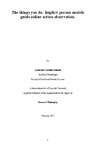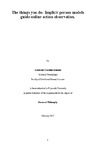The things you do: Implicit person models guide online action observation.
| dc.contributor.supervisor | Wyer, Natalie | |
| dc.contributor.author | Schenke, Kimberley Caroline | |
| dc.contributor.other | Faculty of Health | en_US |
| dc.date.accessioned | 2017-03-16T09:58:50Z | |
| dc.date.available | 2017-03-16T09:58:50Z | |
| dc.date.issued | 2017 | |
| dc.identifier | 10327837 | en_US |
| dc.identifier.uri | http://hdl.handle.net/10026.1/8639 | |
| dc.description | Full version: Access restricted permanently due to 3rd party copyright restrictions. Restriction set on 16.03.2017 by SC, Graduate School | |
| dc.description | Experiments 1a, b and d from Chapter Two have been published in a peer-reviewed journal: Schenke, K. C., Wyer, N. A., & Bach, P. (2016). The Things You Do: Internal Models of Others’ Expected Behaviour Guide Action Observation. PLoS One, 11(7), e0158910. http://dx.doi.org/10.1371/journal.pone.0158910. | en_US |
| dc.description.abstract |
Social perception is dynamic and ambiguous. Whilst previous research favoured bottom-up views where observed actions are matched to higher level (or motor) representations, recent accounts suggest top-down processes where prior knowledge guides perception of others’ actions, in a predictive manner. This thesis investigated how person-specific models of others’ typical behaviour in different situations are reactivated when they are re-encountered and predict their actions, using strictly controlled computer-based action identification tasks, event-related potentials (ERPs), as well as recording participants’ actions via motion tracking (using the Microsoft Kinect Sensor). The findings provided evidence that knowledge about seen actor’s typical behaviour is used in action observation. It was found, first, that actions are identified faster when performed by an actor that typically performed these actions compared to another actor who only performed them rarely (Chapters Two and Three). These effects were specific to meaningful actions with objects, not withdrawals from them, and went along with action-related ERP responses (oERN, observer related error negativity). Moreover, they occurred despite current actor identity not being relevant to the task, and were largely independent of the participants’ ability to report the individual’s behaviour. Second, the findings suggested that these predictive person models are embodied such that they influenced the observers own motor systems, even when the relevant actors were not seen acting (Chapter Four). Finally, evidence for theses person-models were found when naturalistic responding was required when participants had to use their feet to ‘block’ an incoming ball (measured by the Microsoft Kinect Sensor), where they made earlier and more pronounced movements when the observed actor behaved according to their usual action patterns (Chapter Five). The findings are discussed with respect to recent predictive coding theories of social perception, and a new model is proposed that integrates the findings. | en_US |
| dc.language.iso | en | |
| dc.publisher | University of Plymouth | |
| dc.subject | Action Prediction | en_US |
| dc.subject | Perception and action | en_US |
| dc.subject | Social neuroscience | en_US |
| dc.subject.classification | PhD | en_US |
| dc.title | The things you do: Implicit person models guide online action observation. | en_US |
| dc.type | Thesis | |
| plymouth.version | non-publishable | en_US |
| dc.identifier.doi | http://dx.doi.org/10.24382/762 | |
| dc.type.qualification | Doctorate | en_US |
| rioxxterms.version | NA |
Files in this item
This item appears in the following Collection(s)
-
01 Research Theses Main Collection
Research Theses Main



